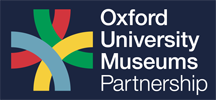On 23rd April 2013, over 40 delegates from around the country gathered at the Ashmolean Museum in Oxford for a day of discussion around fundraising from Trusts and Foundations. Delegates came from organisations such as the Barber Institute, Museums Sheffield, Birmingham Museums Trust and the Royal Albert Memorial Museum to share their knowledge and experiences in discussions led by:

Dynastic Egypt and Nubia, Ashmolean Museum
Helen Duncan, Trusts and Foundations Manager, Ashmolean Museum
Liz Hardingham, Research and Trusts Officer, Ashmolean Museum
Sally Colvin, Collections Coordinator, Museums Association
Paul Mainds, CEO, River & Rowing Museum
Helen Vincent, Development Manager, River &Rowing Museum
Bill Bruty, Director, Fundraising Training Ltd
Tom McNeil, Trusts and Foundations Officer, Oxford University
Trusts and Foundations
Helen and Liz from the Ashmolean’s Development Team kicked off the day with an overview discussion of the pros and cons of engaging with Trusts and Foundations, top tips on identifying appropriate funding opportunities, and how to build relationships with funding organisations.
While there are over 9,000 Trusts in the UK that exist to give away money, and the funding application process is relatively clear and straightforward, it is important to bear in mind that leveraging funding from grant making trusts is highly competitive and the application process can take several months. These organisations also often require significant added value for their investment, and prefer to support new activity, so are not necessarily the best sources of top up funding for projects or core activity.
Helen and Liz pointed out the importance of approaching the right organisation for your project, and to respond to their specific criteria, and not blanket the market with a standard application as different organisation will both have different priorities that will need emphasis, and their own format in which they like to receive and assess applications. For researching funders Helen and Liz recommended:
Although Trusts and Foundations generally have different expectations to individual donors when it comes to cultivation and stewardship, it can be beneficial to engage key trustees as though they were major individual donors - see our post on Individual Giving. It is also important to keep on top of their required reporting process. Not only is it good practice, but it helps to nurture a good relationship with the organisation and lay positive groundwork that can be helpful if you consider approaching them in the future to fund other projects. Helen and Liz suggested that you should read their requirements carefully, inform them of any changes to the planned activity, send photographs and marketing material, and emphasise the difference that their support has made to your organisation.
Download Helen and Liz’s slides
Next to share with the group was Sally Colvin, who is responsible for the various Trusts and Funds that are administered by the Museums Association. Sally gave a review of all the funding opportunities supported by the MA from the Benevolent Fund for members in distress, smaller pots for specific areas of work, such as social history and textile conservation, and the major Esmée Fairbairn Collections Fund.
Sally explained that the Esmée Fairbairn Collections Fund is a partnership between the Esmée Fairbairn Foundation and the MA to support time-limited collections work outside the scope of an organisation’s core resources, with sums ranging from £20-100k. As someone who reads applications regularly Sally advised to focus on addressing the criteria and responding to as many as possible. She also noted that the application isn’t a time to be modest, and that in this current competitive climate it is important of excite the trustees about the project. Tell them exactly why the project is so great, why it should be you, why it should be now, and the added benefit to will bring to your organisation.
Download Sally’s slides
Case Study: River RowingAfter lunch Paul and Helen from the River & Rowing Museum gave a lively case study on some of their fundraising successes. Paul emphasised the three Rs: Relevance, Reputation and Rapport.
The River& Rowing Museum, which opened in 1998, is entirely privately funded, receiving no revenue from the government, and relying on the commercial and fundraising activity. Their galleries are sponsored by corporates, or individual patrons. For example, the museum’s gallery devoted to Henley is primarily sponsored by the corporate Invesco Perpetual, after who the gallery is named and their logo appears on the building itself. However, the gallery needed about an extra £100k a year to cover running costs, and this is given by the , a group of Patrons who give generously each year to support the gallery.
One example of a successful funding bid that Paul and Helen shared with the group was an HLF Your Heritage application for educational activity around the annual Swan Upping tour made by the Queen’s Swan Marker and to coincide with the special events that were happening around the jubilee. Paul noted that key to the success of the bid was that it was a good and timely project, and that the museum had engaged with the HLF before and had a proven track record as an applicant and partner.
Paul similarly emphasised the importance of Reputation and Rapport when seeking capital funding for the museum’s River Gallery. The gallery was broken into 10 separate areas, dealing with different themes, and the museum sought to fund each individually. For the War section the museum approached the Biffa Award, and although they were initially unsuccessful in a Flagship Scheme application, largely due to the fact that it was very similar to a project that the organisation had funded in the previous year, the museum had built up a good relationship with the funders, who liked the project and steered them towards their Major Grants scheme, where the application was successful.
Download Paul’s slides

River & Rowing Museum, Henley
Making an elloquent case study for Funding
Next Bill Bruty, Director of Fundraising Training Ltd, took the group through how to best use the Charity Commissions website to research funders, how to position your project to make it most attractive to funders, and how funding applications are assessed.
When researching Trusts on the Charity Commission website Bill recommends not just looking at what kind of activity they fund and at what level, but also their pattern of income and expenditure. Do they fund the same organisations to a similar amount each year? This may indicate that most of their income is wrapped up in long term obligations and they do not have a great capacity to support new projects. Is their income static or increasing? If it is increasing, this may indicate that they are actively seeking new and interesting prospects.
When deciding how to pitch your project, Bill recommended casting it within Ansoff’s matrix for funding proposals. The matrix considers whether the method you are using is new, and whether the audiences you are engaging are existing or new. Projects that fit into categories two and three are the most attractive to funders.
1. Same People/Same Method: These proposals are your long established programmes that are effective, but require little adaptation. These are difficult to present to external funders as there is little room for change to meet their agendas.
2. New People/Same Method: This is where you are taking a proven methodology and using it to address the needs of a new group of beneficiaries. This could be the replication of an effective way of working with similar beneficiaries in new locations
3. Same People/New Method: This is where you are working with the same beneficiaries, in the same locations – but you are applying new ways of working with them. These methods may be proven by other organisations, or by your own organisation in other locations or with different beneficiaries. However, for the proposed beneficiaries these methods are new and unique. These proposals are attractive to external donors as they are built upon proven success, but have elements of innovation.
4. New People/New Method: This is where you are working with new beneficiaries using new ways of working. Whilst these projects may appear innovative and exciting, for external donors they may be too risky.
Next the group took on the role of Trustees and assessed some short real funding applications against 14 key criteria which Bill identified as common to most funding opportunities.
- How many beneficiaries?
- What are their specific needs?
- What are the aims of your organisation?
- How does your organisation engage its beneficiaries?
- How does your work connect with other organisations?
- What is the relevance of the project to our policies?
- What are the project aims/outcomes?
- What are the key activities?
- What is the timescale for the project and when does it start?
- How much do you need?
- How will you monitor your progress?
- How will you evaluate the project?
- How will you fund the project in the long run? Or,….
- How will you disseminate the results if it is a one off activity?
Download Bill’s slides

Managing the Application Process
To end the day Tom McNeil from the shared his insights on best practice for managing the applications process. His key message, regardless of whether you are using a simple excel document or a sophisticated interface, is that an established system that allows you to track key deadlines and interactions is vital.
Investing in such a system can seem time consuming and of less immediate importance than cultivating relationships and making applications, especially at the outset. However, the long term benefits are worthwhile. You will eventually have a large pool of prospects that you need to keep on top of, and without a proper record keeping and reminder system, important dates can be easy to miss.
Tom’s top tips for creating a database included:
- With simpler systems (Excel, Access, etc.) your challenge will be a lack of functionality. With more complex systems your challenge will be striking a balance between getting the most out of the system and keeping things simple.
- Think about what you want to get out of the system first, then consider which fields and systems match what you want to use.
- Once you have these key fields established – use them so consistently that they become absolute second nature. You will start developing 100% confidence in your system (database as the “single source of truth”).
- Try to do your database updating as you go, rather than seeing it as a separate task.
Download Tom’s slides

